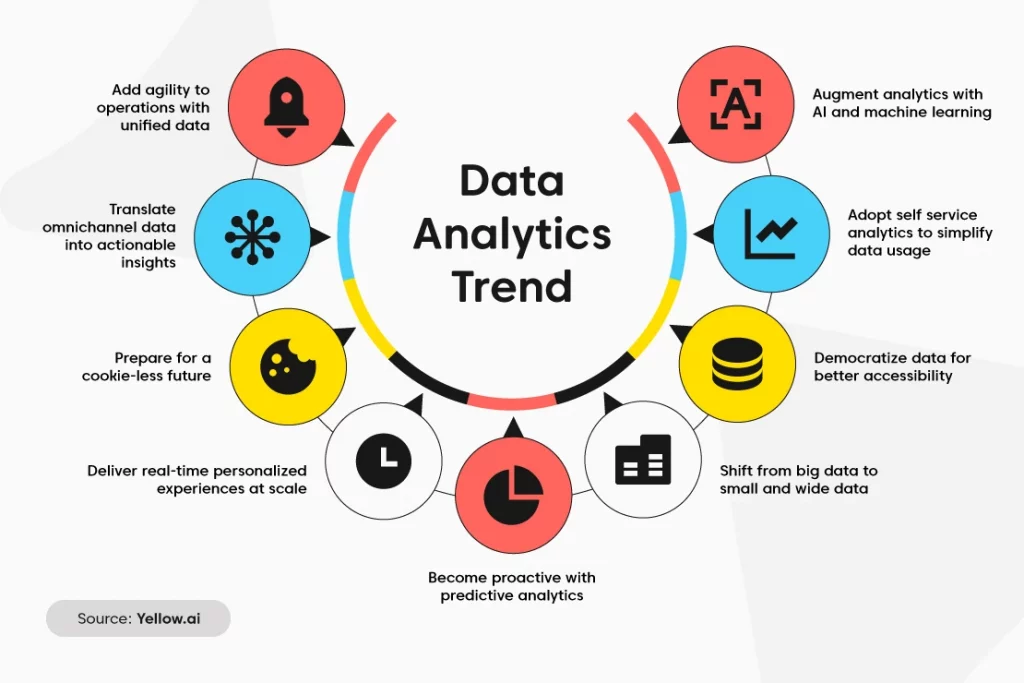“We are surrounded by data but starved for insights.” – Jay Baer, customer experience and marketing expert.
In the last few years, businesses of all sizes have been rushing to mine and refine the ‘new oil’ known as data, which is populating the digital environment like never before. The tremendous data surge has changed the way people do business, and businesses are continuously looking for new methods to capitalize on this unprecedented data explosion.
For 2022 and beyond, data and analytics are going to be shaped by the 9 trends that we’ll take you through in this article. These trends will help you efficiently gather as well utilize every ounce of valuable data to propagate business intelligence.

Top 9 trends shaping the future of data analytics
1. Add agility to operations with unified data
The most difficult barrier between you and unified data is fragmentation. Currently, your data ecosystem may include a variety of storage solutions such as data lakes, data warehouses and databases. You have structured datasets extracted from your company CRM as well as unstructured data obtained from third-party vendors. This arrangement creates data silos, preventing you from realizing the full potential of your client touch points.
Since data is often gathered from diverse channels, platforms and systems, companies need to look for ways to centralize and standardize it. Data can then be queried, accessible, and triggered in ways that facilitate real-time decision-making.

2. Translate omnichannel data into actionable insights
Businesses must know their customers in order to provide relevant experiences. That requires understanding their behaviors, goals, preferences and needs. One more data point can completely change an organization’s understanding of an audience or an experience.
According to recent research, up to 82% of marketing experts see new and shifting customer journeys fueled by data insights. Businesses that effectively convert omnichannel data into insights can identify key touchpoints in the customer journey and then create personalized experiences that leave a lasting impression.
3. Prepare for a cookie-less future
Prior to cookies, ad space resembled an ‘online highway billboard’ rather than the personalized experience it has become. With cookies, marketers obtained new techniques to track visitor activity and gain a deeper understanding of their website’s users.
However, as Google and Apple plan to deprecate third party cookies, the future of customer engagement will be based on consented first-party data. Businesses that are prepared to handle this transition and can act on first-party data will have a market advantage.
4. Deliver real-time personalized experiences at scale
Modern businesses compete not on the basis of their products or cost, but on their ability to provide exceptional customer experiences. Even the most appealing story or content will only elicit customer action when the time is right. As a result, businesses have a real chance to increase customer engagement by embracing the potential of real-time personalization.
Simply put, real-time personalization refers to a company’s capacity to deliver contextually relevant content to each customer or prospect at any point of interaction. Personalizing information in real time, such as offers and recommendations, begins with a real-time, 360-degree view of customers.
5. Become proactive with predictive analytics
Data analysts used to analyze many complex metrics and algorithms to answer problems. However, thanks to recent advances and predictive methodologies, it is now possible to analyze existing data to identify potential problems before they occur.
Companies can generate credible forecasts about what will happen in the future using current predictive analysis, allowing any company to drastically improve its performance by predicting customers’ next moves before they happen. This will lead to the growth of the global predictive analytics market, which is projected to reach $22.1 billion by the end of 2026 at a CAGR of roughly 24.5%.

6. Shift from big data to small and wide data
A recent report by Gartner predicts that, by 2050 70% of enterprises will move from big data to small and wide data (or data that comes from a variety of sources). Owing to the developments in the fields of artificial intelligence (AI) and machine learning, companies can now utilize approaches that search for relevant insights within small or micro data tables to analyze a combination of small and large (as well as structured and unstructured) data.
Access to big, small and diverse data sources is a critical capacity that organizations will likely continue to leverage in the coming years, allowing for greater context for analytics and intelligent decision-making.
7. Democratize data for better accessibility
Data democratization refers to the practice of making data available to everyone in a company, not only the C-suite and IT department. This concept of comprehending and accessing data regardless of technical expertise could lead to the development of new self-service data analytics solutions. Low-code solutions are already demonstrating this.
Data democratization has a lot of advantages to look forward to, mainly because it is at the core of digital transformation. Because data democratization enables many departments to study and exploit data sets, a company’s understanding of customer intent will broaden and it will allow for more tailored customer experiences.
On the other hand, it will pave the way for a widespread usage of effective solutions such as AI analytics. Employees will actually be able to comprehend the data they have access to on a deeper level, regardless of their technical expertise.

8. Adopt self service analytics to simplify data usage
Self service analytics is a useful consequence of data democratization that allows business professionals to perform queries and generate reports on their own, with minimal IT support.
Automation of Data & Analytics has made self-service BI solutions even more crucial in cutting operational expenses in recent years. This style of fact-based decision-making is a good business strategy because it simplifies data interpretation for both technical and non-technical personnel.
According to a recent Mordor Intelligence report, the self-service BI industry would increase at a CAGR of 15.5% by 2026. Based on the increasing demand, it is evident that enterprises will continue to implement self-service data Analytics solutions in 2022 to support more fact-based, day-to-day decision-making.
9. Augment analytics with AI and machine learning
AI-powered analytics will help businesses make better decisions and improve the efficiency of their operations. AI can help with data collection, data analysis and data visualization. In addition to removing the need for human analysts to manually assess and interpret large amounts of data in a timely manner, AI tools also provide real-time insights into what actions should be taken based on the current situation.
AI is already being used to reduce fraud and error at financial institutions by using machine learning models that are trained on historical data points from previous transactions.
Insurance companies are using it as well so they can automate things like claims processing. We’re also seeing more and more examples in other industries where AI is helping businesses identify patterns in their operations so they can improve performance. This AI adoption in data and analytics is only expected to increase over time
Conclusion
We’ve covered so many exciting data and analytics trends here, from data democratization to the rise of artificial intelligence. The future is looking bright—and it’s certainly looking analytical!
Artificial intelligence will be more widely adopted by organizations as they move away from manual processes. AI will take on complex tasks that humans can only perform slowly or inefficiently, such as processing natural language or analyzing unstructured data sets. This will allow organizations to make faster decisions based on more robust information.
Talk to us to learn more about how you can implement AI-powered solutions to make your business decisions more data-driven.

















